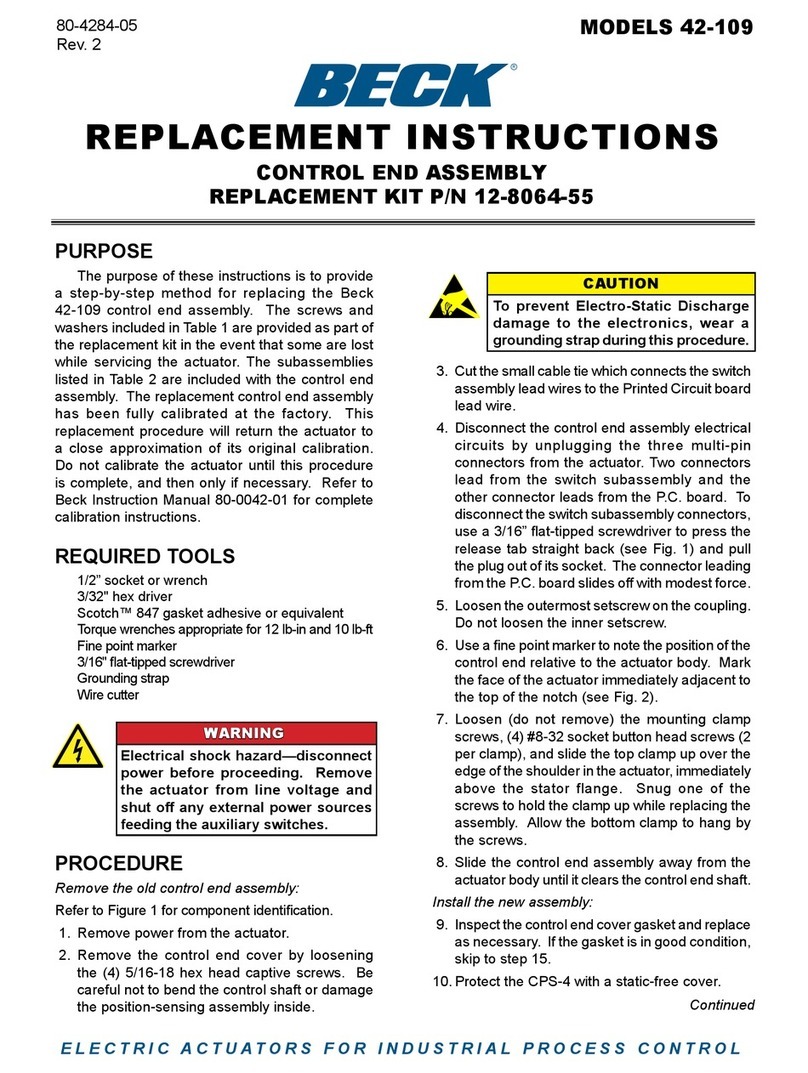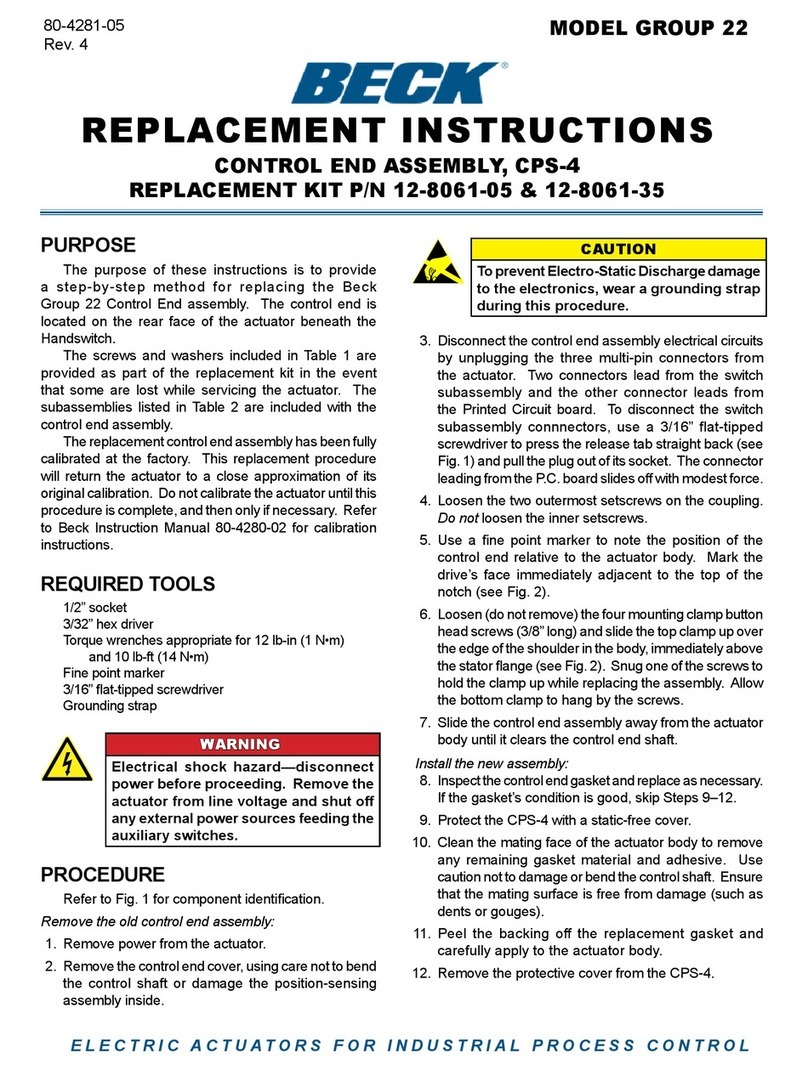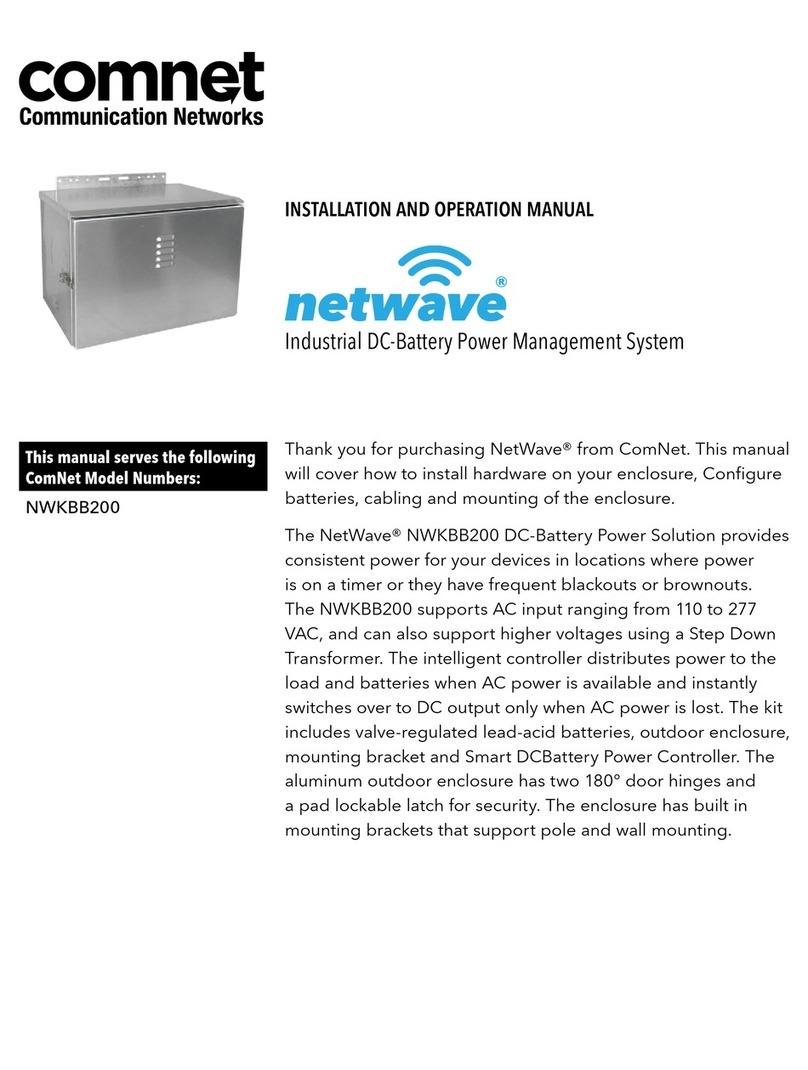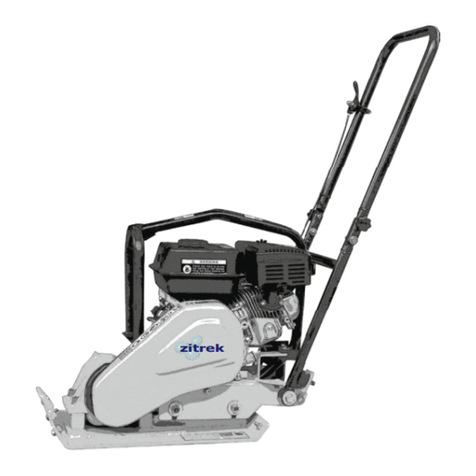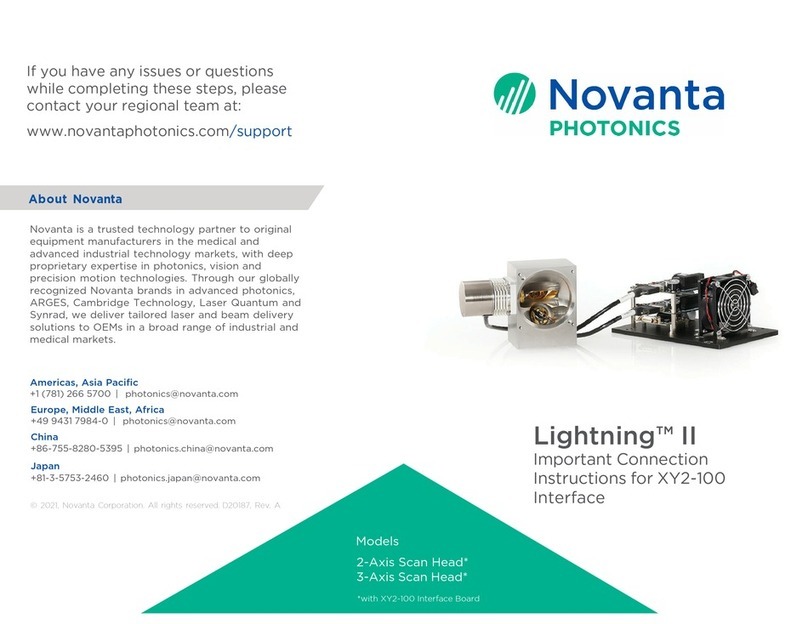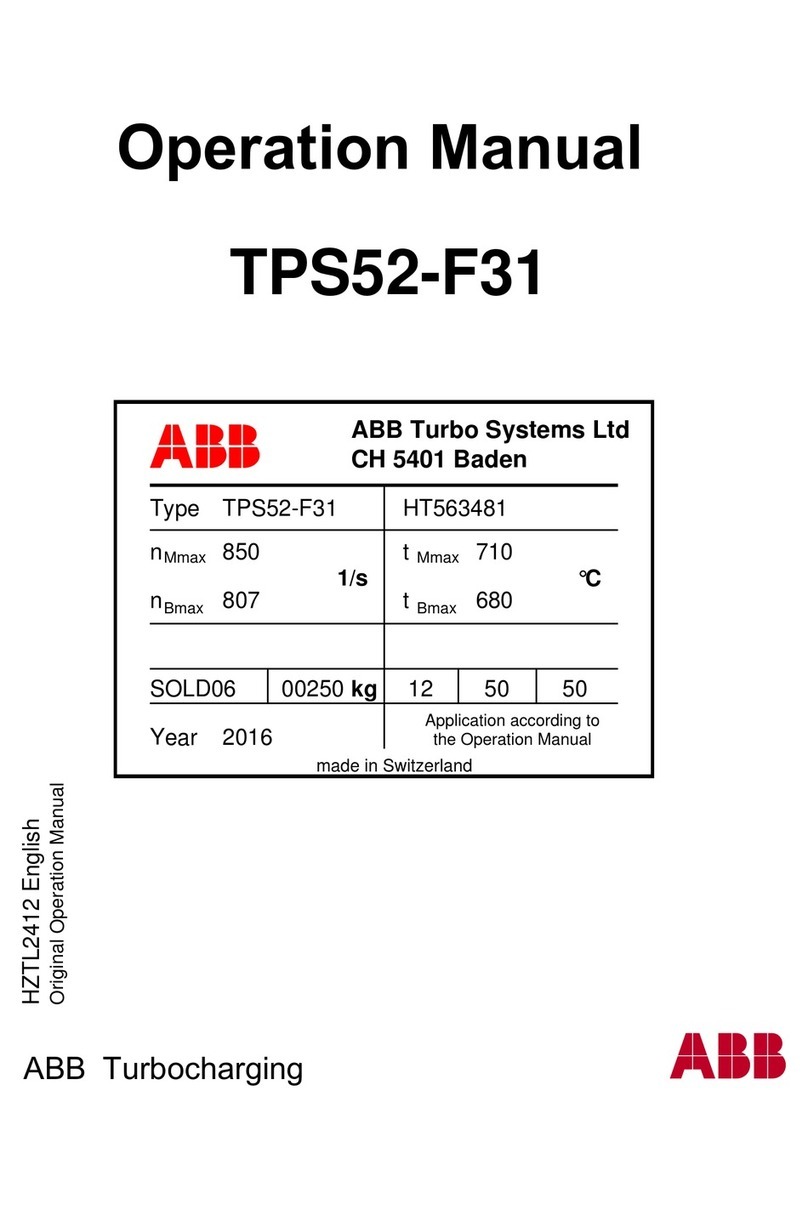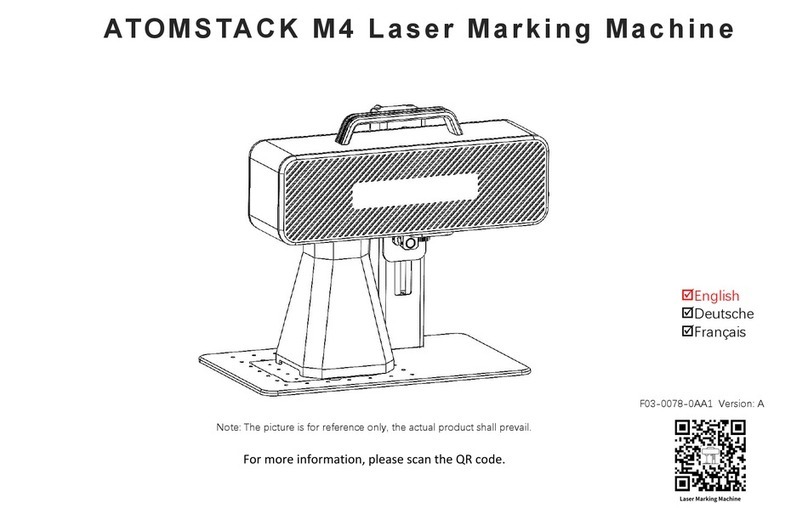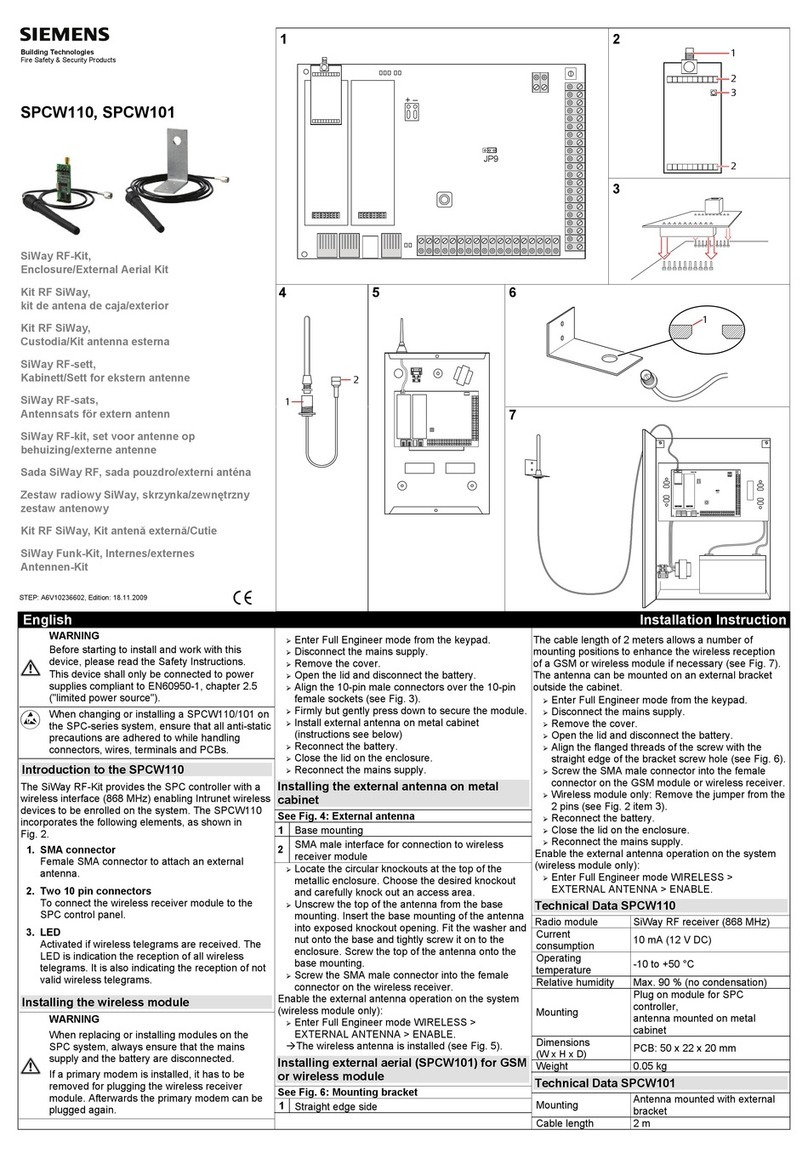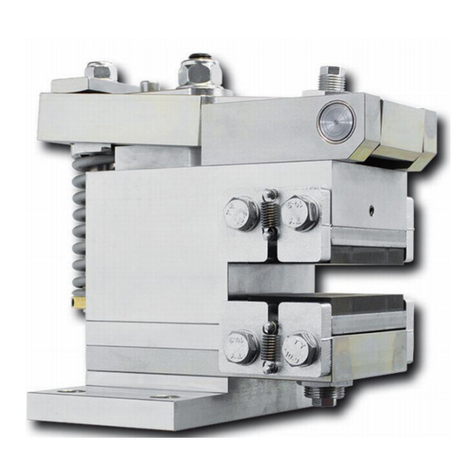Beck 11-439 User manual

1
80-1143-03
Rev. 03.1
INSTRUCTION MANUAL
11-439MODEL
ELECTRIC ACTUATORS FOR INDUSTRIAL PROCESS CONTROL

2
80-1143-03
NOTICE: This manual contains information
that will make installation simple, efficient
and trouble-free. Please read and understand
the appropriate sections in this manual before
attempting to install or operate your drive.
CONTENTS
Product Description ................................................................................................................................... 3
General Specications ............................................................................................................................. 4
Outline Dimension Drawings.................................................................................................................... 6
Installation ................................................................................................................................................... 8
Signal Wiring............................................................................................................................................ 9
Start-up .................................................................................................................................................. 10
Operation ................................................................................................................................................... 12
Digital Control Module (DCM)................................................................................................................... 14
DCM Local Interface ............................................................................................................................ 15
Operation ............................................................................................................................................ 15
Calibration........................................................................................................................................... 17
Switches .......................................................................................................................................... 18
Demand ........................................................................................................................................... 20
Position............................................................................................................................................ 22
Direction Change............................................................................................................................. 23
Troubleshooting .................................................................................................................................. 24
DCM HART®Interface .......................................................................................................................... 26
Communication................................................................................................................................... 26
Conguration and Setup ..................................................................................................................... 36
Calibration........................................................................................................................................... 40
Switches .......................................................................................................................................... 42
Position............................................................................................................................................ 44
Feedback......................................................................................................................................... 46
Demand ........................................................................................................................................... 47
Torque Measurement....................................................................................................................... 48
Maintenance ....................................................................................................................................... 49
Alarm Messages.............................................................................................................................. 49
Troubleshooting............................................................................................................................... 52
DCM Serial Interface ............................................................................................................................ 56
Setup .................................................................................................................................................. 56
Commands ......................................................................................................................................... 57
Command Error Codes....................................................................................................................... 62
Maintenance............................................................................................................................................... 63
Routine................................................................................................................................................... 63
Component Replacement ...................................................................................................................... 64
Appendix .................................................................................................................................................... 68
Spare Parts ............................................................................................................................................ 68
Components........................................................................................................................................... 69
Index ........................................................................................................................................................... 70
Services...................................................................................................................................................... 71

3
80-1143-03
POSITION SENSING AND
FEEDBACK DEVICE
TRAVEL LIMIT
AND AUXILIARY
SWITCHES
DIGITAL CONTROL
MODULE (DCM)
WIRING TERMINAL BLOCK
GEAR TRAIN AND
MOTOR HOUSINGS
LOCATION OF MAJOR COMPONENTS
BECK LINKAGE KITS
Beck pipe linkage kits are available for complet-
ing the mechanical connection from the drive crank
arm to the load. Through the use of a standardized
selection, the linkage can be ordered even if the
exact length is not determined until the drive and
driven device are installed.
All Beck 11-439 drives are furnished with a
crank arm and rod end (see pages 6 and 7 for
dimensions). All rod ends furnished by Beck incor-
porate bearings to accommodate some lateral mis-
alignment. Once the connection is made, linkage
kits can be adjusted ±1 1/2” without removal of the
crank arm or load lever, making nal mechanical
calibration simple.
See page 10 for linkage requirements.
PRODUCT DESCRIPTION

4
80-1143-03
PRODUCT DESCRIPTION
GENERAL SPECIFICATIONS—ALL MODELS
Operating Conditions -40° to 85°C (-40° to 185°F)
0 to 100% relative humidity
Communication Interface HART protocol, local pushbutton/LED panel and RS-232 Serial
commands.
Demand input Signal Options 4–20 mA (1–5 V dc input is possible with the removal of the "R-in"
(DCM) resistor located on the DCM board (see diagram on page 67).
Adjustability for Split Range 0%: 0.1 V to 4 V dc
Operation 100%: 0% + 1 V min. to 5 V max.
Step Size 0.15% typical (congurable).
Linearity ±1% of span, max. independent error
Hysteresis 0.25% of span at any point.
Demand input Signal Linear: Drive output shaft moves proportionally to the input signal.
Characterization Square: Drive output shaft moves proportionally to the square of the
input signal.
Position Feedback Signal 4–20 mA
for Remote Indication
Isolation Demand input and position Feedback signals are isolated from ground
and the ac power line. Signal buffering provides 24 V dc isolation
between the Demand and Feedback signals.
Action on Loss of Power Stays in place.
Action on Loss of Input Stays in place or drives to any preset position (congurable).
Signal (Power On)
Stall Protection If the motor tries to run in one direction for more than 300 seconds
(Optional) (congurable from 30 to 300 seconds), the DCM will shut off power to
the motor (feature can be enabled/disabled).
Drive
Power
120 V ac, single-phase, 60 Hz (standard), 50 Hz (optional)
208, 240, 380, 415, 480 & 575 V ac, 50 or 60 Hz (optional)
Allowable Tolerance: +10%
- 15%
Voltage
Model Power (W) 120 208 240 380 415 480 575
11-430 400 3.10 1.79 1.55 0.98 0.89 0.78 0.65
Max. Current (Amps) by Supply Voltage (V ac)

5
80-1143-03
GENERAL SPECIFICATIONS—ALL MODELS (cont’d)
Overtorque Protection The DCM-2 shuts off power to the motor if the measured output torque
(Optional) of the drive exceeds 150% (adjustable from 70% to 150%) of the drive
rating (feature can be enabled/disabled).
Alarm Annunciation 120 V, 80 mA max. available at terminal E (not available on drives
congured for 240V operation).
Temperature Indication Measures the internal temperature of the drive and triggers an alarm
when the temperature exceeds the rating range.
Over-travel Limit Switches Two SPDT (CW and CCW) provide over-travel protection.
Auxiliary Switches Up to four 6 A, 120 V ac switches available.
Switches are labeled S1 to S4 and are cam-operated, eld-adjustable.
Unless otherwise specied, auxiliary switches are factory set:
S1 and S4 are set to operate just before reaching the CCW travel limit.
S2 and S3 are set to operate just before reaching the CW travel limit.
Handswitch Permits local electrical operation, independent of controller signal.
Standard on all units.
Handwheel Provides manual operation without electrical power.
Motor 120 V ac, single-phase, no-burnout, non-coasting motor has instant
magnetic braking. Requires no contacts or moving parts.
Gear Train High-efciency, precision-cut, heat-treated alloy steel and ductile iron
spur gears. Interchangeable gear modules permit eld change of
timing.
Mechanical Stops Prevent overtravel during automatic or manual operation.
Enclosures
11-409 Drive Type 4X, precision-machined, aluminum alloy castings painted with
corrosion-resistant polyurethane paint, provide a rugged, dust-tight,
weatherproof enclosure.
Gear Reduction Unit Precision-machined, aluminum alloy casting painted with corrosion-
resistant polyurethane paint, provides a rugged, dust-tight,
weatherproof enclosure.

6
80-1143-03
OUTLINE DIMENSION DRAWINGS
RECOMMENDED BOLT TORQUES
BECK MODEL 11-439
ORIENTATION A
Front View Side View
SIZE TORQUE
GEAR REDUCTION UNIT (in.) (lb-ft)
Crank Arm Bolts (4) 3/4-16 420
Rod End Nut 3/4-16 200
Crank Pin Bolts (3) - Std. Arm 3/4-16 420
Crank Pin Bolts (3) - Alt. Arm 3/4-16 300
11-400 DRIVE
Cover Bolts 5/16-18 10
Motor Bolts 3/8-16 16
Gear Module Bolts 5/16-18 10
Adaptor Plate to Gear 1/2-13 45
Reduction Unit Bolts (4)
OUTPUT MAXIMUM
NET SHAFT OVERHUNG
TORQUE TIMING WT DIA. LOAD
(lb-ft) (sec.) (lb.) (in.) (lb.)
5,200 108
180
790 3 15/16
20,000
(Crank Arm p/n
14-8022-42)
or
2,900 72
120
15,000
(Crank Arm p/n
14-8022-44)
18 15/16
10 1/8 8 13/16
14 3/8
3 1/23 1/2
2 63/64
28 13/32
19 1/32
5
12 7/8 11 9/16
11 7/16 10 1/8
10 13/16
6 13/64 6 1/6
1 19/32
Gear
Module
Assembly
90° Elbow
1" N.P.T.
Conduit
Power
Connection
Allow 10"
min. for
Access
5 3/8
7
Cover, Position
Sensing Devices
4 21/32
2 3/16
2 5/8 ±1/8
9 3/16
1 9/16
7 1/8
7 19/32
10 1/4
1 1/2 10 1/64 4 3/4
17 13/32
24 39/64
Allow 4" For Removal
1/2" N.P.T. Conduit
Signal Connection
29 1/16
Allow 9" For Removal
11 7/8 ±3/8

7
80-1143-03
CRANK ARM
BOLTS (4) 6.5"–10.5"
[165–266]
CRANK PIN
BOLTS (3)
ROD END NUT
AND
CRANK PIN
1 1/2-12 UNF x
2 5/8 DEEP
5 3/8
[136]
CRANK ARM BOLTS (4)
CRANK PIN BOLTS (3) ROD END NUT
AND
CRANK PIN
9”–15”
[228–381]
19
[482]
5 3/8
[136]
1 1/2-12 UNF x
2 5/8 DEEP
All Dimensions are in inches
and are subject to change.
ORIENTATION B
Front View Side View
AVAILABLE CRANK ARMS (WITH ROD ENDS)
STANDARD CRANK ARM
(p/n 14-8022-42)
ALTERNATE CRANK ARM
(p/n 14-8022-44)
Thread Size
Dim. "C"
Dim. "D"
Dim. "W"
Angle
1 1/2–12
1.312"
1.500"
2.000"
6.5°
ROD END DETAIL
10 1/8 8 13/16
14 3/8
3 1/23 1/2
7
5 3/8
Gear
Module
Assy.
7/8
11 9/16
10 1/8
28 13/32
2 63/64
18 15/16
11 7/16
12 7/8
21 5/8 Max.
Allow 9" for Removal
19 1/32
Allow 10" Min.
For Access
Cover,
Terminal Block
External Wiring
1/2" N.P.T. Conduit
Signal Connection
24 1/8
21 3/4
24 39/64
Allow 4" For Removal
17 13/32
4 3/410 1/64
10 1/4
7 1/81/2
1 9/16
9 3/16
2 5/8 ±1/8
2 3/16
11 7/8 ±3/8
1" N.P.T. Conduit
Power Connection
4 21/32

8
80-1143-03
INSTALLATION
SAFETY PRECAUTIONS
WARNING
Installation and service instructions are for use
by qualied personnel only. To avoid injury and
electric shock, do not perform any servicing
other than that contained in this manual.
STORAGE INFORMATION
The 11-439 should be stored in its shipping
crate in a clean, dry area.
If it is necessary to store the drive outdoors for
a long period of time, it should be stored above
ground and covered with a waterproof cover. Do
not stack 11-439 crates on top of one another.
Stored drives should be checked periodically to
make sure no condensation has formed in the
electronic and terminal compartments. Damage
due to moisture while in storage is not covered by
warranty.
UNPACKING
The drive is shipped in a slatted wooden crate.
The crate is braced internally at the top and sides
of the drive. To unpack, remove the top of the
crate rst. Then remove the sides of the slatted
crate, carefully removing the support braces. After
unpacking, the skid may be used to transport the
drive to the installation site.
MOUNTING INSTRUCTIONS
The Beck 11-439 can be installed in any conve-
nient orientation because the gear train does not
require an oil bath. Refer to the outline dimension
drawings for physical dimensions and required
clearances.
The 11-439 must be bolted rmly to a mounting
surface which will not yield to the stresses cre-
ated from operating the device. Use 1” diameter
grade 5 bolts and torque to 480 Ib-ft. A at, rigid,
vibration-free surface will generally prolong the life
of the drive’s components. Place shims under the
feet of the drive to correct for any unevenness in
the mounting surface before the mounting bolts
are tightened.
The output shaft of the drive should be paral-
lel to the driven shaft, and the linkage should be
perpendicular to the plane of the two shafts. Small
misalignments can be tolerated if a rod end tting
is used on the driven lever similar to that provided
on the Beck crank arm.
ORIENTATION OPTIONS
The choice of the two available orientation
options depends on the installation and the need
to access the wiring and electrical adjustments of
the 11-409 drive. Normally the orientation option is
selected at the time of order and factory-assembled
to that specication. The orientation option can
be changed. Caution: Consult the factory before
attempting to change the drive orientation.
Orientation Option A (Page 6)
The 11-439, orientation option A, is bolted to
a removable wooden pedestal with four 3/4” hex
head bolts. These bolts are not to be used for
mounting the drive to its nal mounting platform.
The pedestal provides a mounting base for the
drive and also protects the 11-400 control motor.
Do not remove the drive from the pedestal or the
protective cover from the motor until the drive is
ready to be placed on its nal mounting platform.
The pedestal is attached to the wooden shipping
skid with metal banding.
Orientation Option B (Page 7)
The 11-439, orientation option B, is bolted directly
to the wooden shipping skid. These bolts are not to
be used for mounting the drive to its nal mounting
platform. Do not remove the drive from the skid or
the protective cover from the motor until the drive is
ready to be placed on its nal mounting platform.
MODEL 11-439 CONTROL DRIVE
Adaptor Plate
Pilot Shoulder
Assembly Bolts (4)
11-400 Body Only
Lifting Points (3)
Gear
Reduction
Unit
Eye Bolts for Lifting Assembly
Mounting Holes (4) for
Mounting Assembly
Mounting Feet (2)

9
80-1143-03
INSTALLATION—ELECTRICAL
NOTE: All Beck drives are shipped from the
factory ready for installation; no electrical ad-
justments are required before placing them in
operation. Each drive is set up and calibrated
to the customer’s specications that were writ-
ten into the equipment order.
Two N.P.T. conduit connections are provided
for power and signal wiring to the drive. The 1/2"
conduit is provided for signal wiring connections,
and the 1" conduit is provided for power and aux-
iliary switch connections. A sealant must be used
on threaded conduit connections to keep moisture
out. Conduits should be routed from below the
drive so that condensation and other contaminants
entering the conduit cannot enter the drive.
A large, clearly labeled terminal block on the
top of the drive is enclosed in a separate, gasketed
metal enclosure. Terminals will accommodate up
to 12 AWG wiring. See page 3 for location of the
terminal block.
CAUTION
Always close covers immediately after instal-
lation or service to prevent moisture or other
foreign matter from entering the drive.
Refer to the wiring diagram furnished with your
Beck drive for proper AC power and signal con-
nections. It is advisable to provide normal short
circuit protection on the AC power line. A copy of
the wiring diagram is shipped with each drive and
is fastened to the inside of the terminal block cover.
If there is no wiring diagram available, you may
obtain a copy from Beck by providing the serial
number of your drive.
For maximum safety, the Beck drive body
should be grounded. Use the grounding terminal
in the wiring compartment of the drive.
INSTALLATION—SIGNAL WIRING
Each Beck drive is congured to match the
control requirements of your system specied at
the time of order. Each drive has a specic wir-
ing diagram attached to the inside of the wiring
terminal cover. Typical wiring connections are
described below.
A drive can be ordered with up to four optional
auxiliary switches. Wiring connections for these
are described on pages 18 & 42.
To prevent Handswitch initiated motion,
remove the jumper between terminals A and C.
CAUTION: AC power to the drive must be
turned off before removing the jumper.
Typical Wiring Connections
Power and Demand Input Connections
Customer must supply 120 V ac to power the drive
and control circuitry. 120 V ac line connects to terminal
C and neutral to terminal B. Input signal wires connect
to terminals AA (+) and BB (–).

10
80-1143-03
INSTALLATION START-UP
LINKAGE REQUIREMENTS
In most applications, the best control will
result when the linkage is adjusted so that the
full 100° angular travel of the Beck drive shaft
is used, even though the driven shaft may travel
less than 100°.
The general requirements for a good linkage
are:
1. It must be rigid enough to carry the link thrust
without bending or deforming.
2. It must have a built-in means of adjustment so
that the length of the connecting link can be
changed a small amount.
3. Rod end bearings, similar to those furnished
on the Beck crank arm, should be used at
both ends of the connecting link. This type of
device permits small angular misalignments
and helps prevent binding of the linkage.
4. The radius of the Beck crank arm must be cal-
culated so that it will move the damper lever
through the correct arc as it travels from 0° to
100°.
5. The drive and driven shafts must be parallel
and the linkage should be in a plane perpen-
dicular to the shafts.
The following procedure is recommended to
couple the linkage between the Beck drive and
the driven shaft:
1. Position the driven shaft to it's fully closed
position.
2. Set the driven shaft lever to its predetermined
starting angle in relation to the driven shaft
and drive shaft centerline.
3. Remove the rod end from the Beck crank
arm. Thread the rod end fully onto the con-
necting link.
4. Adjust the connecting link to the predeter-
mined length.
5. Connect the connecting link to the driven le-
ver at the predetermined radius.
6. Set the crank pin (see illustration on page 7)
on the Beck crank arm to the predetermined
radius (6.5–10.5 inches or 9–15 inches,
depending on the crank arm); this is done
by loosening the crank pin bolts and sliding
the crank pin to the predetermined position.
Tighten the crank pin bolts to the torque rec-
ommended on page 6.
7. Loosen the crank arm bolts. CAUTION: The
crank arm will pop free—approximate weight
is 125 lbs.
8. Position the drive’s output shaft to correspond
with the driven shaft's fully closed position.
9. Swing the crank arm into position and as-
semble the rod end to the crank arm crank
pin. Tighten the rod end nut to the torque
recommended on page 6.
10. Tighten the crank arm bolts evenly, in a
cross-pattern, to the torque recommended on
page 6.
11. Lubricate the rod end bearings with LGI #1
EP grease, Mobil grease #28 or equivalent.
12. Carefully move the drive’s output shaft to
correspond with the driven shaft's fully open
position. Check that no binding occurs be-
tween the linkage, crank arm, driven shaft
lever, and surrounding obstructions. Also, ob-
serve that the driven shaft rotates the proper
amount. Ensure that the drive reaches the
proper limit and shuts off. If binding in the
linkage occurs due to too much travel of the
driven lever, reduce the crank arm radius
on the Beck drive rather than adjusting the
connecting link length. Return to step 5 and
repeat adjustments.
If necessary, the linkage length may be adjusted
by altering the thread engagement in the couplings.
The couplings have right- and left-hand threads,
so it is not necessary to disconnect the ends to
make a length adjustment. The stud threads must
be engaged 1.2 diameters deep into the rod ends.
Make adjustments by altering thread engagement
in couplings only. Be careful not to expose more
than 7” of stud between rod end and coupling.
Once again, check operation to determine that
no binding occurs between the linkage and crank
arm or driven shaft lever. Surrounding objects must
not interfere.
Do not change limit switch settings to obtain
desired driven shaft lever travel. This shortens the
travel of the feedback device and reduces the con-
trol resolution, repeatability, accuracy of the drive,
and available torque.
For an input control signal change, do not ad-
just the linkage. Refer to the applicable Calibration
section of this manual.
Link-Assist™
The Beck Link-Assist™ computer program
opti mizes the linkage conguration for your load’s
torque characteristics to help you select the min-
imum drive size for your application. Contact
your Beck Sales Engineer to take advantage of
Beck’s Link-Assist™ program.

11
80-1143-03
Linkage Kits Available
Standard Beck linkage kits are made to
accom modate a wide variation in linkage lengths
without requiring modication of end ttings. This
adapt ability makes it possible to order the es-
sential linkage end connections even though the
exact linkage length may not be known until the
drive is mounted in place.
Each linkage kit includes the essential pipe
linkage end connections and all necessary hard-
ware except for pipe and crank arm rod end. To
simplify installation of the pipe link, the kit ac-
cepts N.P.T. right-hand threads on both ends of
the pipe. Left-hand threads are internal to the
linkage kit assembly, making nal length adjust-
ments quick and easy.
To order Pipe Linkage Kits, rst obtain the
approximate overall linkage length “A”. Select
the kit part number from the table below. For
lengths beyond those listed in the table, contact
your Beck Sales Engineer. Additional Linkage
information can be found in the Beck Drive Spec-
ication Guide (DSG).
11-439 PIPE LINKAGE KITS
1Does not include customer supplied pipe.
2Use when the angle between the linkage and crank arm is less than 25°.
*NOTE: To calculate length of
pipe required, subtract Length
of 2 Linkage Ends (shown in
the table below) from Linkage
Length (“A”).
START-UP INSTRUCTIONS
After the drive is mounted and its wiring con-
nections are made, it is ready to be tested for
proper operation.
NOTE: All Beck drives are shipped from the
factory ready for installation; no electrical ad-
justments are required before placing them in
operation. Each drive is set up and calibrated
to the customer’s specications that were writ-
ten into the equipment order.
Turn on the power supply. Operate the drive
with the Handswitch and run it through its full
stroke, both directions. Observe that the driven
device travels through its desired stroke. If satis-
factory, set Handswitch to the “AUTO” position.
Turn on the controller and operate the drive by
varying the control signal. Check that the damper
strokes in the proper direction for a change in con-
trol signal. If it does not, rst check for proper
wiring connections and verify control signal at the
drive. If the wiring is correct, then change the
direction of output shaft rotation (see applicable
instructions on page 23, 41 or 58).

12
80-1143-03
OPERATION
HOUSING
The 11-439 consists of a Beck 11-409 Control
Drive assembled to a 3:1 gear reduction unit. The
11-439 has cast aluminum compartments for each
of the ve main components: The control motor,
wiring terminal board, drive train, digital control
module, and control end. Gasketed covers and
sealed shafts make this product ideally suited to
outdoor and high-humidity environments.
The gear reduction unit is cast aluminum and
provides a rugged, dust-tight, weatherproof en-
closure.
Heavy mechanical stops built into the housing
are designed to prevent accidental over-travel
damage during manual cycling, and ensure that
proper orientation is maintained between the out-
put shaft and the feedback system.
CONTROL MOTOR
The Beck control motor is a synchronous in-
ductor motor which operates at a constant speed
of 72 or 120 RPM in synchronism with the line fre-
quency. Motors are able to reach full speed within
50 milliseconds and stop within 25 milliseconds;
actual times will vary with load. Beck motors have
bearings with added, double grease seals and re-
quire no maintenance for the life of the motor.
GEAR TRAIN
The 11-439 gear train is a four-stage reduction,
spur gear drive constructed with only heat-treated
alloy steel and ductile iron gears for durability and
long life.
The drive train consists of the control motor
and Handwheel, reduction gears, main gears, and
splined output shaft. The main gear / output shaft
and third stage gears are built into the drive hous-
ing. The second and rst stage gears are part of
the eld-interchangeable gear module. Different
combinations of gear modules and drive motors
determine the drive’s output torque and timing.
The drive train in the gear reduction unit is a
single-stage reduction, spur gear drive consisting
of a ductile iron gear and a heat-treated alloy steel
pinion. An internal spline in the pinion engages
with the external spline on the output shaft of
the 11-439. In this way, the output torque of the
11-439 is increased by a factor of 3.
The output shaft is limited by mechanical stops
to 108° of rotation. Mechanical transmission of the
output shaft position to the control end is provided
by a right angle gear set driven directly by the
11-439 output shaft.
SELF-LOCKING
MECHANISM (SLM)
An integral part of every control motor is the
self-locking mechanism. This mechanical device
couples the motor to the gear train and transmits
full motor torque when rotated in either direc-
tion. When the motor is de-energized, the SLM
instantaneously locks and holds the output shaft
in position.
HANDWHEEL
Every Beck control drive is furnished with a
Handwheel to permit manual operation of the
damper without electrical power. Its solid con-
struction design includes no spokes or projections,
and turns at a safe, slow speed. The Handwheel
is located at the rear of the control motor housing.
The Handwheel is coupled directly to the motor
shaft and rotates when the motor runs. Manual op-
eration of the Handwheel (with electric Handswitch
in “STOP” position) turns the motor and the rest of
the drive train without incorporating a clutch.
HANDSWITCH
A local electric Handswitch is provided on Beck
drives to permit operation at the damper, indepen-
dent of the controller. As a safety feature, the
Handswitch is designed so that the controller can
operate the drive only when it is in the “AUTO”
position. The sequence of the Handswitch is:
“AUTO”, “STOP”, “CW”, “STOP”, “CCW”.
In the “AUTO” position, two contacts are closed
and the DCM completes the control circuit.
In the “CW” or “CCW” positions, contacts are
closed to operate the drive independently of the
controller.
In the “STOP” position, all contacts remain
open.
To prevent Handswitch initiated motion, re-
move the jumper between terminals A and C.
CAUTION: AC power to the drive must be
turned off before removing the jumper.
SWITCHES
Two over-travel limit switches and up to four
optional auxiliary switches are provided on Beck
drives. Switch cams are clamped onto the con-
trol shaft which rotates in relation to the output
shaft. Cam position is eld-adjustable. Switches
are rated 6 A, 120 V ac. All auxiliary switch con-
nections are made on the terminal block.

13
80-1143-03
LOSS OF DEMAND INPUT
SIGNAL (L.O.S.)
When the Demand input signal drops to
approximately –5%, the DCM considers the
Demand input signal to be invalid. DCMs are
typically configured to stop the drive during
L.O.S. conditions, but may be congured by the
factory or by using the HART or Serial interface
to run the drive to a predetermined position.
Under the L.O.S. condition, the “STAT” and “DE-
MAND” LEDs will light. When the input signal
is corrected, the drive will automatically resume
normal operation. The value for LOS activation
is congurable using the HART (see page 39) or
Serial interface (see page 59). Alarm indication
is available at terminal E.
POSITION:
CONTACTLESS POSITION
SENSOR (CPS)
The CPS provides the DCM with a continuous
feedback signal proportional to the position of the
drive’s output shaft.
The position sensing function of the CPS is
provided by a ferrite magnetic sensing element.
An electronic circuit translates the signal from the
ferrite magnetic sensor into a position signal used
by the DCM to control the drive. The typical output
voltage of the CPS ranges from 1.0 V at the CCW
end of travel, to 5.0 V at the CW end of travel. A
4–20 mA position feedback signal is available for
remote position indication (see page 9). If the CPS
Position signal to the DCM is out of the calibrated
range limits, the "STAT" and "POSITION" LEDs will
light. Alarm indication is available at terminal E.
TORQUE PROTECTION (FOR
DRIVES EQUIPPED WITH THIS
OPTION)
DCM-2s are equipped with a torque sensing
module that will light the “STAT” and “TRQ/
THRUST” LEDs in the event excessive torque
is detected. This alarm is normally set to
activate when torque exceeds 105% of the
drive rating. Torques above 150% of the drive
rating will cause the DCM-2 to stop trying to run
in the direction of the high torque. When the
over torque condition is corrected, the drive will
automatically resume normal operation. The
torque sensing module also provides a number of
torque related features using the HART interface
(see page 48). Torque alarm may be enabled or
disabled using the HART (see page 48) or Serial
interface (see page 71). Torque alarm levels may
be adjusted using the HART or Serial interfaces.
Alarm indication is available at terminal E.
STALL PROTECTION AND
ANNUNCIATION
If the drive output shaft cannot reach a desired
position within approximately 300 seconds, the
DCM shuts off power to the motor and the “STAT”
and “STALL” LEDs will light. The stall condition
timing is factory congurable (or congurable using
the HART or Serial interface) from 300 seconds to
as low as 30 seconds and is initially set according
to the specication at time of order.
A sensed stall condition is cleared by either
reversing the Demand input signal from the control-
ler (such that the drive tries to run in the direction
opposite the blocked direction), performing a "Reset
Stall" or "Board Reset" using the HART interface
(see page 34), or by switching the drive power off
and on. Alarm indication is available at terminal E.
TEMPERATURE
DCMs are equipped with a temperature sens-
ing circuit. The “STAT” and “TEMP °F” LEDs
will light when the drive’s ambient temperature
exceeds the rating of the drive. Specic tem-
perature readings are available using the HART
(see page 34) or Serial (see page 61) interface.
Alarm indication is available at terminal E.
FEEDBACK SIGNAL
The feedback sourcing module provides a
4–20 mA analog output signal that represents the
drive output shaft position in terms of 0–100% of
full rotational travel (congurable via the HART
(see page 46) or Serial (see page 60) interface).
This signal can be remotely monitored or used
by a controller or indicator. The “STAT” and “FB
OPEN” LEDs will light if the function is enabled
and there is no current in the loop. The Feedback
signal can be factory congured as disabled, or
disabled using the HART (see page 38) or Serial
(see page 60) interface. Alarm indication is avail-
able at terminal E.
STOP/LIMIT INDICATION
The “STAT” and “STOP/LIMIT” LEDs will
light if the Handswitch is in the “STOP” position.
These LEDs will also light if the drive is at a limit
and is not in balance. Alarm indication is avail-
able at terminal E.

14
80-1143-03
INPUT: DIGITAL CONTROL
MODULE (DCM)
Beck modulating drives are equipped with a
precision, digital control module (DCM) designed to
receive conventional 4–20 mA or 1–5 V dc control
signals directly.
The DCM modulates the drive output shaft in
response to an analog Demand input signal and is
designed to operate continuously in temperatures
up to 185°F.
The DCM provides intelligent calibration, easy
drive setup changes, and diagnostic information.
A Local interface provides quick pushbutton
setup and diagnostics without the need for a hand-
held or remote device (see page 15). A HART
communications interface allows remote access
of all features and information (see page 28). A
Serial interface also allows for drive conguration
changes, drive information reporting and to assist
in troubleshooting (see page 56).
The DCM permits two or more Beck drives to
be operated by a single signal source. See pages
21 and 48 for details on split range operation.
A square function is available to position the
drive’s output shaft proportionally to the square
of the input signal. This function is factory
congurable (specify at time of order) or may be
congured using the HART interface (see page
38) or Serial interface (see page 59).
DIGITAL CONTROL MODULE (DCM)
POSITION
DEMAND
TRQ/THRUST
STALL
FB O PEN
STOP/LIMIT
ACKNOWLEDGE
TE MP F
CALIBRATE
SET POS
100%
SET DEM
100%
SET DEM
0%
SET POS
0%
R
FWD
REV
STAT
PWR

15
80-1143-03
DCM LOCAL INTERFACE Operation
OVERVIEW
The DCM customer interface panel (pictured
below) allows the user to easily calibrate the drive
and troubleshoot conditions. The following infor-
mation provides an overview of the DCM customer
interface panel features.
NOTE: Beck drives are shipped from the fac-
tory set up and calibrated to customer spec-
ications placed at the time of order and are
ready for installation.
Overview LEDs
The four LEDs, as highlighted below, indicate
the present state of the drive.
FWD
This LED is lit when the drive is receiving a
Demand signal greater than its position.
REV
This LED is lit when the drive is receiving a
Demand signal smaller than its position.
STAT
This LED is lit when additional status is available.
For details regarding possible conditions, see
“Status Indication LEDs” on page 16.
PWR
This LED is lit when power is applied to the
drive. This LED pulses from bright to dim
indicating the DCM is fully operational.
POSITION
DEMAND
TRQ/THRUST
STALL
FB OPEN
STOP/LIMIT
ACKNOWLEDGE
TEMP F
CALIBRATE
SET POS
100%
SET DEM
100%
SET DEM
0%
SET POS
0%
R
FWD
REV
STAT
PWR
POSITION
DEMAND
TRQ/THRUST
STALL
FB OPEN
STOP/LIMIT
ACKNOWLEDGE
TEMP F
CALIBRATE
SET POS
100%
SET DEM
100%
SET DEM
0%
SET POS
0%
R
FWD
REV
STAT
PWR

16
80-1143-03
Pushbutton Controls
The ve pushbuttons (pictured below) on the
DCM customer interface panel are used for cali-
bration. When pressing a pushbutton, pressure
should be maintained until the “ACKNOWLEDGE”
LED lights; this conrms receipt of the pushbut-
ton command. See the Calibration section, be-
ginning on page 17, for further explanation of the
calibration procedures. Pushbutton functions are
as follows:
CALIBRATE
A safety feature, this button must be
pressed and held while pressing the
pushbuttons described below to set the
Position and Demand signal limits.
CAUTION
Pressing the following buttons may change
calibration and cause the drive to reposition.
SET POS 100%
Press to set the desired 100% position for
drive movement (this will correspond to a
100% Demand signal).
SET POS 0%
Press to set the desired 0% position for
drive movement (this will correspond to a
0% Demand signal).
SET DEM 100%
Press to set the Demand input signal that
corresponds to 100% Demand.
SET DEM 0%
Press to set the Demand input signal that
corresponds to 0% Demand.
Status Indication LEDs
When the “STAT” LED is lit, the applicable status
indication LED(s) (pictured below) will light to reveal
the condition(s) as described below. An alarm is
also available at terminal E. When the condition is
corrected, the status will automatically reset. Each
status LED is described below, with a more detailed
explanation of the function provided on page 13.
DEMAND
Loss of the Demand input signal.
POSITION
The CPS Position signal to the DCM is out of the
calibrated range limits. The lower limit is –5% and
the upper limit is 105% of the calibrated range.
This LED may also indicate a CPS or internal
wiring failure.
TRQ/THRUST
This LED indicates that excessive torque
is present (over 105% of the drive rating).
This LED is functional only when the drive is
equipped with optional torque sensing.
STALL
The drive is in a stall condition and stall protection
has been activated.
TEMP °F.
Drive’s internal temperature is outside of rating.
FB OPEN
External position Feedback signal is enabled,
but not wired to an external load or the wiring
has failed between the drive and the monitoring
device.
STOP/LIMIT
Handswitch is in “STOP” position or the drive is
at a limit and is not in balance.
Status
Indication
LEDs
Pushbutton
Controls
DCM LOCAL INTERFACE Operation
ACKNOWLEDGE
CALIBRATE
SET POS
100%
SET DEM
100%
SET DEM
0%
SET POS
0%
R
FWD
REV
STAT
PWR
POSITION
DEMAND
TQ/THRST
STALL
FB OPEN
STOP/LIMIT
TEMP F
POSITION
DEMAND
TRQ/THRUST
STALL
FB OPEN
STOP/LIMIT
TEMP F
R
FWD
REV
STAT
PWR
CALIBRATE
SET POS
100%
SET DEM
100%
SET DEM
0%
SET POS
0%
ACKNOWLEDGE

17
80-1143-03
All Beck drives are shipped completely cali-
brated to the customer’s specications that were
written into the equipment order and are ready to
be installed. If the need arises to change the drive
calibration, rst conrm that the drive is installed as
specied and operating properly before proceeding
with the change.
Position reference and demand calibration
are performed using the DCM customer interface
panel, but may also be congured using the HART
or Serial interface. Calibration of over-travel limit
and auxiliary switches must be performed using
the procedure beginning on page 18.
CALIBRATION PRIORITY
Model 11-439 drives are equipped with xed,
non-adjustable, built-in mechanical stops. All
output shaft rotation must occur within these stops,
which are approximately 108° apart.
The over-travel limit switches are used to limit
the electrical control range of the drive. These
switches are cam operated and are set slightly
wider apart than the drive’s intended full range
of electronic operation (typically 100°). The limit
switches are positioned to provide an electrical
overtravel protection (typically 101°).
If the drive is short-stroked—i.e., the full travel
rotation from 0–100% is reduced to less than the
standard 100° rotation (see page 22)—it may be
desirable to reset the over-travel limit switches
(see page 18). If the limit switches are not reset,
Handswitch operation of the drive (CW, CCW)
will still result in the original full range of travel.
It is best to calibrate the drive and then set the
limit switches when short-stroking the drive. The
switches should be set just outside the calibrated
range to avoid tripping the switch at the 0% and
100% positions.
The auxiliary switches are also cam operated,
but have no affect on drive and DCM operation.
Therefore, the auxiliary switches can be adjusted
at any time without affecting performance or
calibration.
DCM LOCAL INTERFACE Calibration

18
80-1143-03
NOTE: Your Beck drive was shipped from the
factory ready for installation; no electrical
adjustments are required before placing it in
operation. Each drive is set up and calibrated
to the specications that were written into
the equipment order.
Under normal operating conditions there is no
need to recalibrate the control drive. However,
if the application requirements change or are
different than specied on the equipment order,
the drive should be recalibrated according to the
following procedures.
SWITCH ADJUSTMENTS
Control drives are shipped with over-travel
limit switches factory-set for 101° of travel
unless otherwise specified at time of order.
Limit switches must be set inside the range of
the built-in, non-adjustable mechanical stops
to prevent stalling of the motor. Limit switches
can be reset to limit travel of the output shaft to
any angle down to a minimum of 60°. Auxiliary
switches are set as shown in the gure at left
unless otherwise specied at time of order.
NOTE: The over-travel limit switches are the
switches closest to the drive body. To adjust
the over-travel limit switches, it is necessary
to remove the control end cover.
Switches are operated by cams which are
clamped onto the control shaft. Setting a switch
involves loosening the cam, moving the output
shaft to the desired position, and positioning the
cam so that it just operates the switch at that point.
In the following procedure, the use of a continuity
meter is recommended to determine when the
switch opens or closes. If such a meter is not
available, it is possible to hear the switch click as
the contacts open and close.
CAUTION
Do not attach the meter or attempt to move the
switch cams until the drive is disconnected
from the line voltage and auxiliary switches are
disconnected from external power sources.
Setting Over-travel Limit
Switches CW and CCW
This procedure should be used if the factory
over-travel limit switch settings must be changed
in the eld. It is advisable to operate the drive fully
in each direction, using the electric Handswitch to
check switch settings before attempting to change
them. Follow these instructions if they require
adjustment:
1. Remove the control end cover and terminal
block cover (1/2" bolt heads).
2. Use the electric Handswitch to drive the control
shaft so that the CW switch cam screw is
accessible. Using a 7/64" hex wrench, loosen
the screw so that the cam is just snug on the
shaft (see illustration below).
3. Move the output shaft clockwise to the desired
CW limit.
Standard Over-travel Limit and
Auxiliary Switch Settings
DCM LOCAL INTERFACE Calibration - Switches

19
80-1143-03
4. Turn the Handswitch to the “STOP” position.
5. Disconnect power from the drive.
6. Turn the Handswitch to the "AUTO" position.
7. Connect the continuity meter across terminals
B and M. Rotate the cam until the meter shows
no continuity (switch contacts open, switch
clicks).
8. Tighten the cam locking screw to 5 Ib-in
torque.
9. Disconnect meter and turn the Handswitch to
the "STOP" position.
10. Reconnect drive power.
11. Rotate the drive’s output shaft in the CCW
direction away from the CW travel limit. Note
the direction of rotation of the lobe of the cam.
The correct cam lobe motion is away from the
switch lever with the switch lever on the lower
part of the cam. If not correct, return to step 2
and reset the cam to the proper orientation.
12. Rotate the output shaft again to the desired CW
travel limit. If the stopping point is reached, the
switch is properly set.
13. Repeat instructions for setting CCW travel
limit switch (noting that referenced directions
of rotation should be opposite of those used for
CW switch setting). Connect continuity meter
across terminals B and N.
14. Replace covers and tighten cover bolts to
10 Ib-ft torque.
15. Rotate index to correspond with output shaft
rotation.
Setting Auxiliary Switches
Standard switch settings for drives with 2 or 4
auxiliary switches are shown on the diagram on
page 18. The heavy line indicates a closed circuit.
Follow these instructions to change the operating
point of auxiliary switches:
NOTE: In the following procedure, it is as-
sumed that switch settings are to be adjusted
so that contacts are open when the desired
position is achieved. If they are to be adjusted
to close, it may be necessary to reverse the
operating mode of the switch by moving the
wire lead to the other terminal on the switch
itself. Be sure to disconnect power from the
switch terminals rst.
1. Remove the control end cover and the terminal
block cover (1/2" bolt heads).
2. Use the electric Handswitch to drive the shaft
so that the switch cam is accessible. Using a
7/64" hex wrench, loosen the screw so that the
cam is just snug on the shaft.
3. Move the output shaft to the desired position.
4. Turn the Handswitch to the “STOP” position.
5. Disconnect power from the drive and switch
terminals.
6. Connect the continuity meter across the appro-
priate terminals. See the diagram on page 18
or the drive wiring diagram. Rotate the cam to
operate the switch.
7. Tighten the cam locking screw to 5 Ib-in
torque.
8. Disconnect the meter and reconnect power.
9. Move the drive’s output shaft in the desired
direction to verify that the cam lobe moves
away from the switch lever. If not correct, re-
turn to step 2 and reset the cam to the proper
orientation.
10. Replace covers and tighten cover bolts to
10 Ib-ft torque.
Loosening Switch Cam

20
80-1143-03
DEMAND CALIBRATION
DCM boards are designed to accept a 4–20 mA
(or 1–5 V dc) analog demand signal. Narrower
spans within this range can also be accommodated
for split range operation (see page 21). The input
comes calibrated from the factory for the full range
unless otherwise specied by the customer. It
is not necessary to calibrate the Demand input
when the drive is installed; however, if desired,
it can be easily accomplished using the DCM
pushbutton controls (or HART or Serial interface)
and a signal source. Following this procedure is
only necessary to compensate for slight differences
between the signal source calibration and the DCM
factory calibration, or if reduced range calibration
is desired for special operating scenarios such as
split ranging.
Procedure
1. Remove the DCM cover (1/2” bolt heads).
2. Ensure the Handswitch is in the “STOP”
position. This will prevent the drive from
repositioning during this procedure.
3. Apply the desired 0% Demand input signal to
the drive (e.g., 4 mA for 4–20 mA input). If the
drive has not been wired, the Demand input
signal is connected at terminals AA (+) and BB
(–) as shown in the diagram on page 9.
4. Press and hold the “CALIBRATE” pushbutton
on the DCM customer interface panel, then
press the “SET DEM 0%” pushbutton until the
“ACKNOWLEDGE” LED is lit.*
5. Apply the desired 100% Demand input signal
to the drive (e.g., 20 mA for 4–20 mA input).
6. Press and hold the “CALIBRATE” pushbutton
on the DCM customer interface panel, then
press the “SET DEM 100%” pushbutton until
the “ACKNOWLEDGE” LED is lit.*
7. Turn the Handswitch to the “AUTO” position.
NOTE: The drive may reposition.
8. Run the drive through its full operating range to
ensure proper response to the Demand input
signal.
9. Replace the compartment covers and tighten
the cover bolts to 10 lb-ft torque.
* If the “ACKNOWLEDGE” LED does not light, but
the “DEMAND” LED does light, the signal is out
of acceptable range and was not accepted by the
DCM. This is typically caused by trying to set 0%
and 100% values too closely together (i.e., less
than 4 mA difference).
DCM LOCAL INTERFACE Calibration - Demand
Table of contents
Other Beck Industrial Equipment manuals
Popular Industrial Equipment manuals by other brands
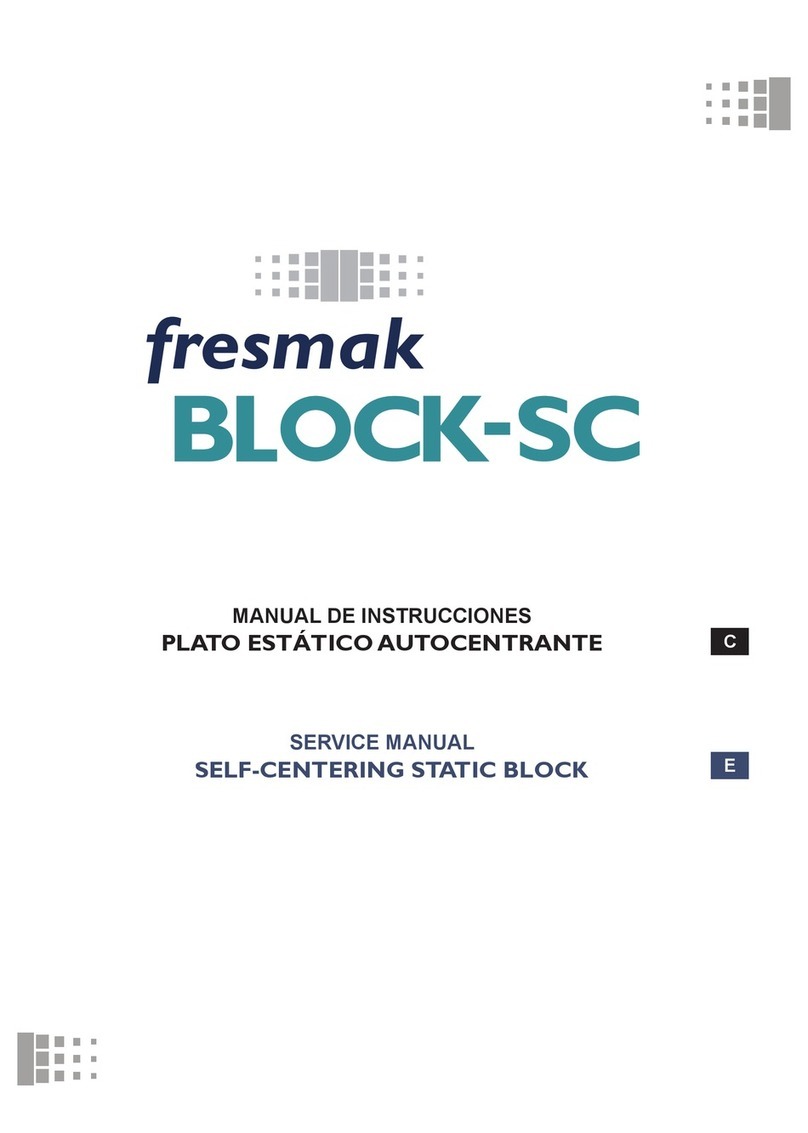
Fresmak
Fresmak BLOCK-SC Service manual
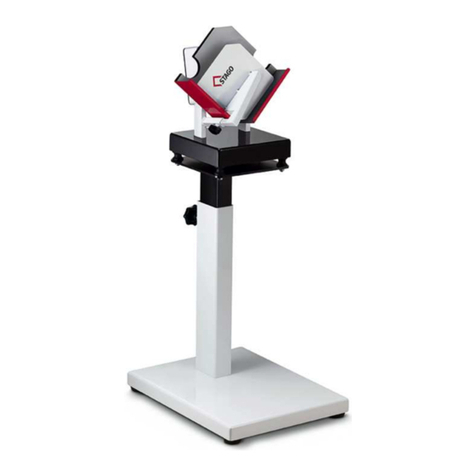
STAGO
STAGO PR 4 Operating instructions and spare parts list
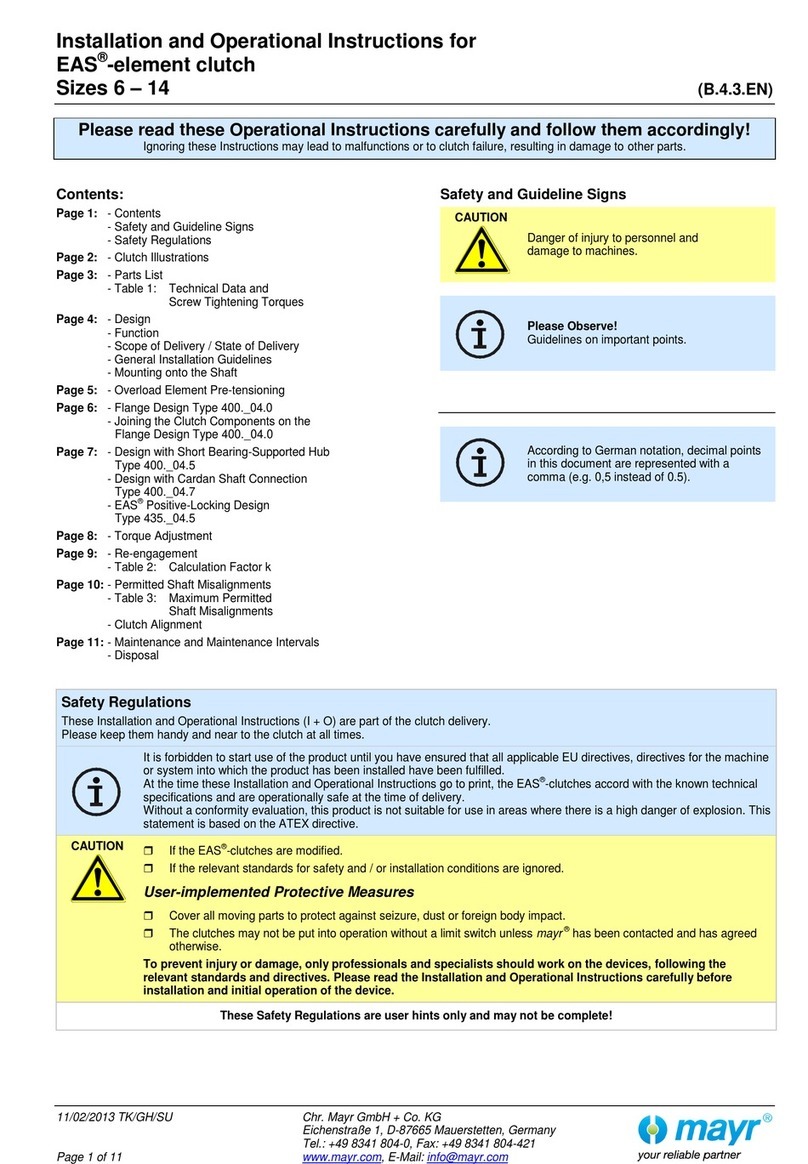
Mayr
Mayr EAS 400 04.7 Series Installation and operating instructions
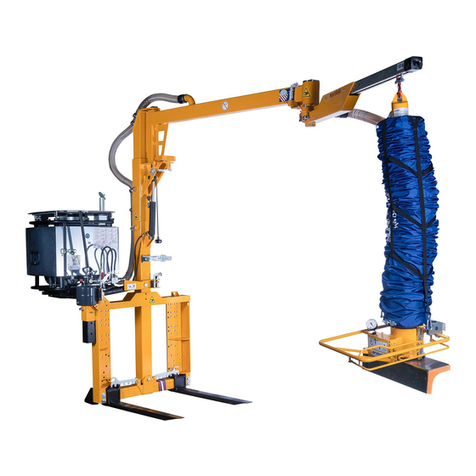
probst
probst JUMBO-BV-VARIO manual
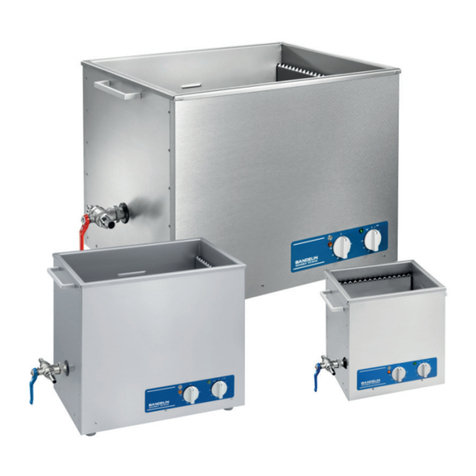
BANDELIN
BANDELIN SONOREX TECHNIK RM 16.2 UH User instructions
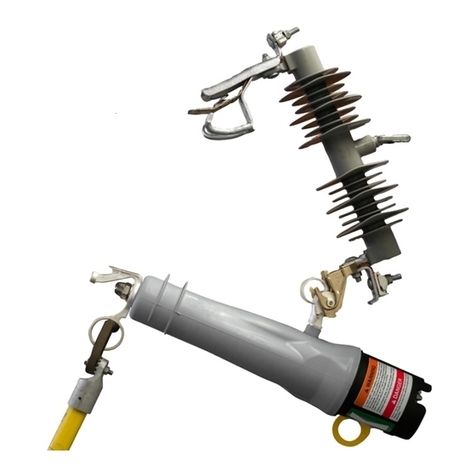
S&C
S&C VacuFuse II Installation and operation manual
